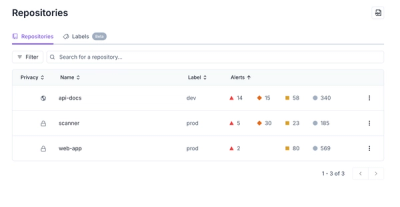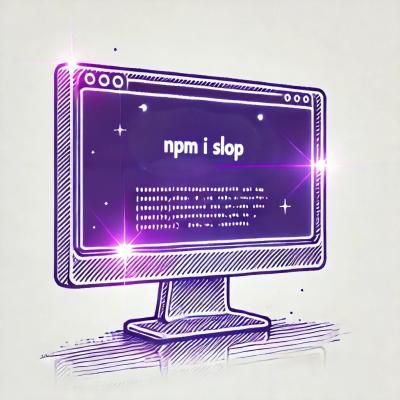
Product
Redesigned Repositories Page: A Faster Way to Prioritize Security Risk
Our redesigned Repositories page adds alert severity, filtering, and tabs for faster triage and clearer insights across all your projects.
@codesherpas/complexity-report
Advanced tools
Software complexity analysis for JavaScript projects
Software complexity analysis for JavaScript projects. Command-line front-end for escomplex. Less attractive elder brother of JSComplexity.org.
Complexity is the quality of consisting of many interrelated parts. When software consists of many interrelated parts, it becomes more difficult to reason about. Software that is difficult to reason about is a more fertile breeding ground for bugs than software that is simple.
Every problem space contains some level of inherent complexity, which is shared by all possible solutions. However, as programmers, we can reduce the complexity of our chosen solutions by limiting the interrelatedness of their constituent components. This is commonly referred to as favouring cohesion over coupling, and forms the bedrock on which axioms such as the single responsibility principle are built.
In codebases that are large and/or unfamiliar, it can be difficult to know whether regions of complexity exist and where they might be. By defining metrics of complexity, the search for offending components can be automated and brought into the existing build process alongside other forms of static analysis and unit tests.
complexity-report is just a node.js-based command-line wrapper around escomplex, which is the library that performs the actual analysis work. Code is passed to escomplex in the form of syntax trees that have been generated with esprima, the popular JavaScript parser.
The readme for escomplex contains a brief overview of the metrics it produces.
The numbers returned by this tool should not be interpreted as definitive indicators of whether a piece of software is "too complex", whatever that might mean.
Software development is a varied field and every project is subject to a unique set of environmental factors. Attempts to set generic hard limits for these complexity metrics must essentially be arbitrary and fail to consider the specific requirements of a given project. Further, complexity itself is such an amorphous, multi-dimensional continuum, that attempting to pigeon-hole chunks of code at discrete points along a single axis is an intrinsically crude approach.
It is better to use this tool as a fuzzy, high-level mechanism, which can identify regions of interest or concern and from which your own programming- and domain-expertise can take over for a more comprehensive analysis.
Although the metrics themselves are not perfect, they can help to identify areas of code that warrant closer inspection. They can also be tracked over time, as an indicator of the direction that overall code quality may be moving in.
The tool can be configured to fail when complexity metrics pass a specified threshold, to aid its usefulness in automated environments / CI. There are also options for controlling how metrics are calculated and the format of the report output.
You must have node.js installed.
Then, for a project-based install:
npm install complexity-report
Or globally for all projects:
sudo npm install -g complexity-report
cr [options] <path>
The tool will recursively read files from any directories that it encounters automatically.
-h, --help output usage information
-c, --config <path> specify a configuration JSON file
-o, --output <path> specify an output file for the report
-f, --format <format> specify the output format of the report
-e, --ignoreerrors ignore parser errors
-a, --allfiles include hidden files in the report
-p, --filepattern <pattern> specify the files to process using a regular expression to match against file names
-P, --dirpattern <pattern> specify the directories to process using a regular expression to match against directory names
-x, --excludepattern <pattern> specify the the directories to exclude using a regular expression to match against directory names
-m, --maxfiles <number> specify the maximum number of files to have open at any point
-F, --maxfod <first-order density> specify the per-project first-order density threshold
-O, --maxcost <change cost> specify the per-project change cost threshold
-S, --maxsize <core size> specify the per-project core size threshold
-M, --minmi <maintainability index> specify the per-module maintainability index threshold
-C, --maxcyc <cyclomatic complexity> specify the per-function cyclomatic complexity threshold
-Y, --maxcycden <cyclomatic density> specify the per-function cyclomatic complexity density threshold
-D, --maxhd <halstead difficulty> specify the per-function Halstead difficulty threshold
-V, --maxhv <halstead volume> specify the per-function Halstead volume threshold
-E, --maxhe <halstead effort> specify the per-function Halstead effort threshold
-s, --silent don't write any output to the console
-l, --logicalor disregard operator || as source of cyclomatic complexity
-w, --switchcase disregard switch statements as source of cyclomatic complexity
-i, --forin treat for...in statements as source of cyclomatic complexity
-t, --trycatch treat catch clauses as source of cyclomatic complexity
-n, --newmi use the Microsoft-variant maintainability index (scale of 0 to 100)
By default,
complexity-report will attempt
to read configuration options
from a JSON file
called .complexrc
in the current working directory.
This file should contain
a JSON object
with property names
matching the long-form
option names
from the command line
(the ones that follow --).
Options set in this file
will be over-ridden
by options specified
on the command line.
See an example configuration file.
You can also specify
an alternative path
to this file
using the -c
command-line option.
Currently there are five output formats supported:
plain,
markdown,
minimal,
json,
xml
and checkstyle.
These are loaded
from the src/formats subdirectory.
If the format file is not found
in that directory,
a second attempt will be made to load the module
without the subdirectory prefix,
more easily enabling the use of
custom formats if so desired.
Adding new formats is simple;
each one must be a CommonJS module,
which exports a function named format.
The format function
should take a report object,
as defined by escomplex,
and return its string
representation of the report.
See the plain formatter for an example.
See the contribution guidelines.
FAQs
Software complexity analysis for JavaScript projects
The npm package @codesherpas/complexity-report receives a total of 1 weekly downloads. As such, @codesherpas/complexity-report popularity was classified as not popular.
We found that @codesherpas/complexity-report demonstrated a not healthy version release cadence and project activity because the last version was released a year ago. It has 3 open source maintainers collaborating on the project.
Did you know?

Socket for GitHub automatically highlights issues in each pull request and monitors the health of all your open source dependencies. Discover the contents of your packages and block harmful activity before you install or update your dependencies.

Product
Our redesigned Repositories page adds alert severity, filtering, and tabs for faster triage and clearer insights across all your projects.

Security News
Slopsquatting is a new supply chain threat where AI-assisted code generators recommend hallucinated packages that attackers register and weaponize.

Security News
Multiple deserialization flaws in PyTorch Lightning could allow remote code execution when loading untrusted model files, affecting versions up to 2.4.0.